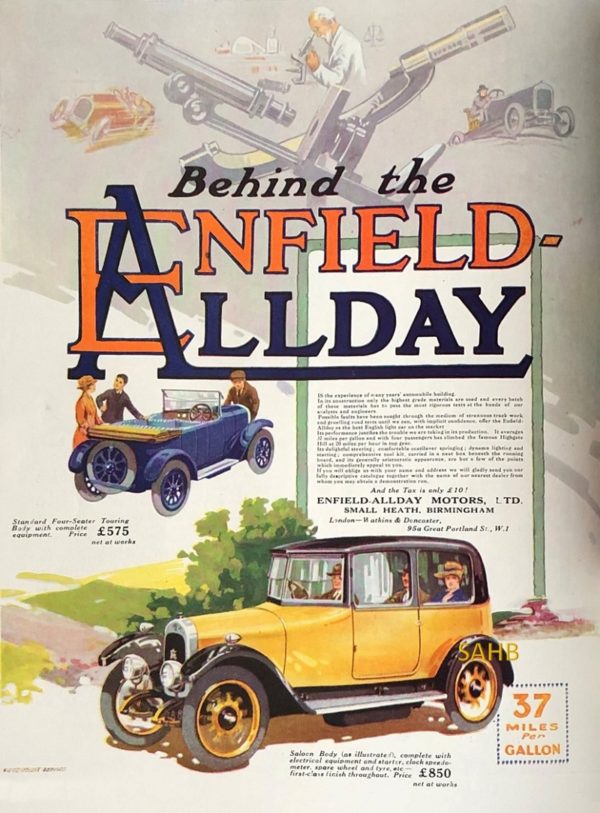
Rarely do middle-market motor manufacturers gain the opportunity to advertise their wares in such sumptuous colour – but this was often the case in that rare and rarefied publication The Motor-Owner. This example, from the June 1921 issue, is full of evocative imagery – from cars both racing and under rigorous test, to a studious scientist, complete with de rigueur white lab coat, clearly investigating the chemistry and/or metallurgy behind the quality of the Enfield-Allday car. A larger microscope of different form is then linked with a micrometer. The message of precision is not lost on the reader.
The two cars are then displayed in more homely countryside surroundings, potential customers by now reassured that their weekend or workday journeys will be uninterrupted by breakdowns – and that they will achieve 37 miles per gallon at the same time.
The copious text builds upon the pictures above and below. It mentions years of experience, the highest grade of materials (every batch being tested in the hands of analysts and engineers), and the strenuous track work and road tests that look for any possible faults. It presents the result: “…the best English light car on the market”, capable of climbing Highgate Hill at 20 mph in top gear with four people on board.
The Enfield-Allday was manufactured in Sparkbrook, Birmingham, from 1919 to 1924. Before World War I Alldays & Onions had produced a range of cars and in 1908 took over the short-lived Enfield Autocar Company based in Redditch, itself having acquired the car-building part of the Enfield Cycle Company.
The first two years after the war produced ideas but no production. A new 10-hp car called the Bullet was designed by A.W. Reeves, formerly of Crossley Motors. This was a radical design, with an air-cooled, five-cylinder, sleeve-valve radial engine of 1247 cc mounted at the front of a tubular steel lattice frame. A.C. Bertelli of Graham-White Aviation Co. was called in to give an opinion and pronounced that the car would need much development and would be uneconomic to produce. Perhaps no more than 5 were ever sold.
Something drastic was needed to achieve production and sales, and Bertelli was appointed Works Manager. He designed a conventional car with an in-line four-cylinder 1488 cc engine with three-speed transmission which was launched as the 10/20 hp that we see in this Snapshot. The coachwork was built by Bertelli’s brother Enrico “Harry” Bertelli, who would later build bodies for Aston Martin.
The prices in this advertisement, £575 for the tourer and £850 for the saloon, were too expensive for the market and the make did not survive long. In 1923 the engine was enlarged to 1750 cc and the car was fitted with a four-speed gearbox. A name change to 12/30 at a lower price of £450 did little to help sales: only about 100 cars were made before the company collapsed in 1923.
There was an attempt to revive the marque in smaller premises, but the parent company Alldays & Onions failed in 1924 and no more cars were made.
Image courtesy of The Richard Roberts Archive.







Leave a Comment